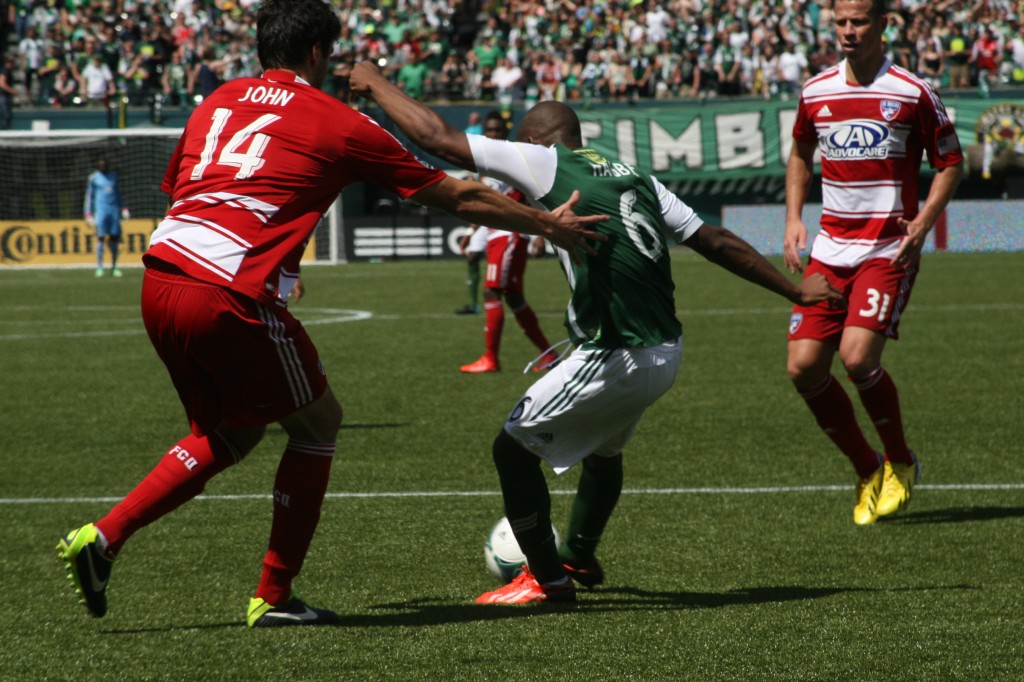Preparing for FC Dallas…

In my previous article “Catching up on the Timbers“… I peeled back some statistical details on Portland’s attack and defense – I’ll not repeat that here but would recommend you have a read or at least refresh your memory if you don’t recall some of the details…
The bottom line in that article was this – the Timbers are not the same team they were in the first seven weeks of the season – and no doubt many are very happy to see that.
In considering the overall improvement, especially in attack, are there any things we may see different this game compared to the away match at Rio Tinto?
I think so, and in particular I offer Caleb considers Maxi Urruti up top to start the game in lieu of Adi – not because Adi didn’t perform – he’s been brilliant.
For me it’s more about what style of defense Caleb expects to encounter. How can we anticipate what type of defensive approach FC Dallas will take?
For starters the best indicator in the public domain data world is Opponent Total Final Third Passes – why?
Well we know from observable facts and validation in talking about this with Caleb (last Thursday) that Toronto is a team that will cede penetration and look to lock down the 18 yard box. Opponents average 138 passes within the Reds defending Final Third.
On the other hand we also know that Chivas (especially if you watched that game at StubHub) will play two banks of four further (higher) atop the 18 yard box. Their opponents average just 96 passes within the Chivas defending Final Third.
So where do FC Dallas fit in with this key performance indicator?
At home, FC Dallas opponents average just 92 passes with their defending Final Third – but when Dallas play on the road their opponents average 138 passes within the defending Final Third.
Therefore; it’s a good bet that FC Dallas will cede penetration and play two tighter banks of four in and around the 18 yard box while also looking to keep them tighter from a width perspective as well.
Given that it’s likely the Timbers will offer up four to five attackers with more speed and quicker short-passing skills to make better use of those tight spaces; this isn’t saying Adi doesn’t have these skills – he does – but Urruti didn’t play last weekend and even with a rest coming up it will be a good thing to keep Maxi sharp.
With an approach like this we might also see Will Johnson or Diego Chara making late runs if FC Dallas get spread wide.
Of course what we don’t really know is who will start in defense for FC Dallas; their list of injured is long across the midfield and back-four.
At this time the MLS Fantasy website (a reasonable source) indicates these players with ‘red injury boxes’; Hedges, Michel, Acosta, Zimmerman, John, Diaz and Thomas are all injured.
How that translates to starters is hard to tell but i’d expect Moffat (Jacobson?), Ulloa, Castillo and Watson to get a look in and if Pareja goes with two up top it’s likely to be Texeira and Akindele.
Since I don’t really know their back-four that well it does appear the Center-back pairing will be a new one – how that communication goes is anybody’s guess – but if it gets pear-shaped early this could be a very long night for Seitz between the pipes.
I’d also expect with newer faces back there Pareja will play even deeper and tighter (10-15 feet apart between the two banks of 4 perhaps?). A good indicator at half-time will be the volume of passes the Timbers offer in the Dallas defending Final Third.
I’ll try to remember to tweet that info at the half…
As a caution – with an increase in volume of passes within the Final Third there is a tendency for teams to be less patient in taking shots – taking an extra dribble or extra pass when a clear shot isn’t present is sometimes better.
The indicators this year still continue to show that teams who take fewer shots put more shots on goal and score more goals – 1.5 goals more per game! Patience is a good thing… If you want to read the article and that major talking point this past weekend at the World Conference on Science and Soccer click this link.
In closing…
Whoever Caleb starts he has flexibility in making adjustments to open up the Dallas defense (be it out wide or down the middle) and we already know the Darlington Nagbe has been simply brutal in penetrating FC Dallas previously.
Part of this game might include some ‘cat-and-mouse’ play where the Timbers look to cede some space to create quick counterattacking opportunities – or – increase pressure higher up the pitch to try and garner turnovers.
With Urruti up top, that hard charging, grinding, quickness comes into play.
In considering all those attacking options the Timbers will look to remain tight inside their own 18 yard box to try and kill the individual speed of the Dallas attack.
A great indicator will be to watch the positional play and rotation between Jewsbury and Villafana (or whoever starts at fullback) when the Timbers are in attack – it is likely one will stay a bit higher while the other rotates a bit lower – all the while checking to make sure either Chara or Johnson stay at or near the center-circle.
Best, Chris

